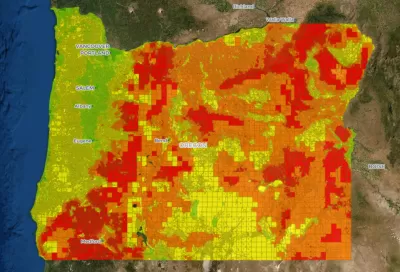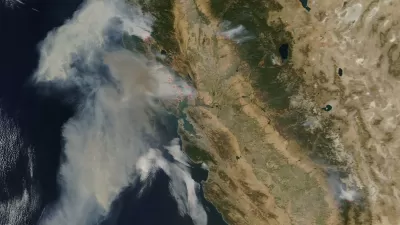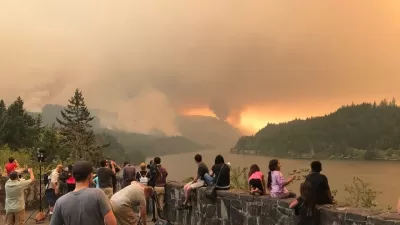After homeowners received letters assessing their property’s fire risk, questions remain about the next steps in building fire resilience.

A new wildfire risk map has drawn questions from Oregon homeowners, reports Tiffany Olin for KTVL. Olin writes, “people across Southern Oregon have received letters in the mail from the Department of Forestry classifying their property as high or extreme risk and within the wildland-urban interface.” But the letters have raised questions since they don’t indicate how homeowners should respond. Derek Gasperini, Public Affairs Officer for Oregon Department of Forestry (ODF), said for now, homeowners just need to be aware of the risk to their home.
According to the article, “The Oregon State Fire Marshal will be passing defensible space codes and other regulations by December of this year that are expected to go into effect by April of 2023.” Gasperini said grants will be available to help homeowners pay for defensible space upgrades, which will be required as part of Senate Bill 762, “passed as a response to the 2020 Labor Day fires across the state.”
Planetizen recently covered a proposal to build a community-wide fire perimeter in Paradise, California. The proposal is in part an acknowledgement that fire protection measures can be expensive or impractical for renters, mobile home owners, and other residents in diverse housing types.
FULL STORY: Oregon's new wildfire risk map sparks questions among Southern Oregonians

Study: Maui’s Plan to Convert Vacation Rentals to Long-Term Housing Could Cause Nearly $1 Billion Economic Loss
The plan would reduce visitor accommodation by 25,% resulting in 1,900 jobs lost.

North Texas Transit Leaders Tout Benefits of TOD for Growing Region
At a summit focused on transit-oriented development, policymakers discussed how North Texas’ expanded light rail system can serve as a tool for economic growth.

Why Should We Subsidize Public Transportation?
Many public transit agencies face financial stress due to rising costs, declining fare revenue, and declining subsidies. Transit advocates must provide a strong business case for increasing public transit funding.

How to Make US Trains Faster
Changes to boarding platforms and a switch to electric trains could improve U.S. passenger rail service without the added cost of high-speed rail.

Columbia’s Revitalized ‘Loop’ Is a Hub for Local Entrepreneurs
A focus on small businesses is helping a commercial corridor in Columbia, Missouri thrive.

Invasive Insect Threatens Minnesota’s Ash Forests
The Emerald Ash Borer is a rapidly spreading invasive pest threatening Minnesota’s ash trees, and homeowners are encouraged to plant diverse replacement species, avoid moving ash firewood, and monitor for signs of infestation.
Urban Design for Planners 1: Software Tools
This six-course series explores essential urban design concepts using open source software and equips planners with the tools they need to participate fully in the urban design process.
Planning for Universal Design
Learn the tools for implementing Universal Design in planning regulations.
City of Santa Clarita
Ascent Environmental
Institute for Housing and Urban Development Studies (IHS)
City of Grandview
Harvard GSD Executive Education
Toledo-Lucas County Plan Commissions
Salt Lake City
NYU Wagner Graduate School of Public Service





























